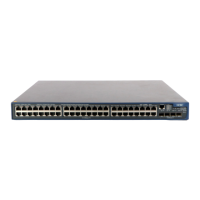1-7
To prevent illegal devices from accessing the network through a port, you can configure static MAC
addresses and disable MAC address learning for the port. Thus, only the packets destined for the
configured MAC addresses can be forwarded out the port.
Related commands: mac-address, mac-address timer.
Examples
# Set the maximum number of MAC addresses Ethernet 1/0/3 port can learn to 600.
<Sysname> system-view
System View: return to User View with Ctrl+Z.
[Sysname] interface Ethernet 1/0/3
[Sysname-Ethernet1/0/3] mac-address max-mac-count 600
mac-address timer
Syntax
mac-address timer { aging age | no-aging }
undo mac-address timer aging
View
System view
Parameters
aging age: Specifies the aging time (in seconds) for dynamic MAC address entries. The age argument
ranges from 10 to 1000000.
no-aging: Specifies not to age dynamic MAC address entries.
Description
Use the mac-address timer command to set the MAC address aging timer.
Use the undo mac-address timer command to restore the default.
The default MAC address aging timer is 300 seconds.
The timer applies only to dynamic address entries, including both entries learnt and configured.
Setting an appropriate MAC address aging timer is important for the switch to run efficiently.
z If the aging timer is set too short, the MAC address entries that are still valid may be removed.
Upon receiving a packet destined for a MAC address that is already removed, the switch
broadcasts the packet through all its ports in the VLAN which the packet belongs to. This
decreases the operating performance of the switch.
z If the aging timer is set too long, MAC address entries may still exist even if they turn invalid. This
causes the switch to be unable to update its MAC address table in time. In this case, the MAC
address table cannot reflect the position changes of network devices in time.
Examples
# Set the aging time of MAC address entries to 500 seconds.
<Sysname> system-view
System View: return to User View with Ctrl+Z.
[Sysname] mac-address timer aging 500

